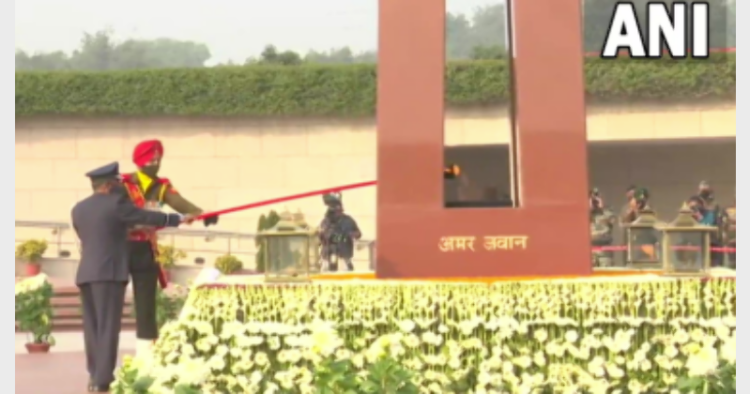Amar Jawan Jyoti flame was the true mark of valour, and it deserved a place at the National War Memorial, not underneath the India Gate, a Colonial-era war memorial.
First thing first. India is not the only country globally that has a memorial of national importance to commemorate war heroes.
The Cenotaph, in London, England, is the national war memorial of the United Kingdom. Interestingly, Edwin Lutyens, the architect who designed the India Gate, also designed The Cenotaph in the 1920s. Now, you may come up with a legitimate question. Does the United States, the nation that emerged as the most powerful after World War II, have a national war memorial?
The World War II Memorial is the United States' national war memorial, and it opened in 2004. Yes, you read that right — 2004. The first resolution to build this memorial was passed in 1987, but it became law only in 1993. The then government started a fund-raising campaign, and it is said that Americans donated millions of dollars to help erect the memorial. Now here's the most interesting part — criticism started as soon as construction began, with the Washington Post deriding it as 'Soviet-style pomposity' and a few others comparing the monument's design approach with Hitler and other tyrants.
Today, millions of Americans every year visit the memorial to simply show appreciation to their martyrs. Here in India, the country that overthrew foreign occupation in 1947 to earn self-rule, the 'new' National War Memorial has become more a matter of ridicule by the opposition, less a mark of respect for Indian martyrs.
The narrative of the media is either distorted or misleading. The only headlines a few media houses have published on the subject matter are about moving the eternal Amar Jawan Jyoti flame to the flame at the new National War Memorial. But before we move any further, is it accurate to use the prefix 'new' with the National War Memorial inaugurated in the presence of the CDS and all other Chief of Staff in 2019? Is it a 'new' memorial or the first?
Now it is time to recall that the India Gate 'continued' to serve as the memorial of national significance until 2019. The Duke of Connaught laid India Gate's foundation stone in 1921, and Lord Irwin inaugurated the monument in 1931. Yes, the same Lord Irwin, India's viceroy who imprisoned several national independence leaders, including Mahatma Gandhi. Irwin also oversaw the hanging of the three of India's most beloved martyrs — Bhagat Singh, Sukhdev, and Rajguru. India Gate was erected as a memorial to commemorate martyrs of the British Indian Army that served in the First World War.
In 1972, the then Prime Minister, Indira Gandhi, added underneath the arch of the India Gate, the Amar Jawan Jyoti, to honour the sacrifices of Indian soldiers in the Indo-Pakistan War of 1971. This eternal flame, a symbol of nationalism for all Indians, was never allowed to extinguish. But another fact is that Amar Jawan Jyoti was too humble a structure to honour Indian war heroes, who deserved a lot more. In fact, India had yet to have a national war memorial. Many may not know the memorial was first proposed in 1960, yes, six decades back. The Congress-led union government dragged its feet on the issue, and it remained an 'unrealized dream' until the BJP-led government assumed control in 2014.
By all measures, terming the National War Memorial, which began in 2017, cannot be termed 'new'. It is the first memorial of national importance that independent India always deserved; our soldiers always deserved.
Now, the key contention — the merging of the eternal Amar Jawan Jyoti flame with the flame at the War Memorial that sits independently of the colonial-era India Gate.
Was it not the foremost duty of the Indian government to first erect a war memorial and then house it with every bit that marks the valour of our armed forces? Amar Jawan Jyoti flame was the true mark of valour, and it deserved a place at the National War Memorial, not underneath the India Gate, a Colonial-era war memorial. On the other hand, the India Gate is also a monument of national importance, but the taint that was built by the then tyrants is not easy to remove. Nevertheless, the India Gate stands as a tribute to Indian soldiers that abided by their duty regardless of the period or the ruling entity.
The World War II Memorial in Washington, D.C., and India's National War Memorial in New Delhi are late additions, but it is never late to do the right thing. And here's the last important bit. The canopy at the India Gate that will now house a statue of one of the leading nationalists of pre-independence India, Netaji Subhas Chandra Bose, once housed a statue of King George V. India, slowly but gradually is moving toward recognizing and honouring the sons of the land.
Neither the merging of the Amar Jawan Jyoti flame nor the decision to erect Bose's statue was a political move, and these were both course corrections.
(The writer is a Chartered Accountant, author, blogger, and served as an Independent Director on the Boards of India’s most influential public sector banks)














Comments